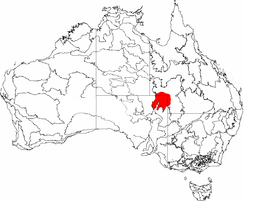Sturt Stony Desert
| Sturt Stony | |
| Sturt's Stony, Stony | |
| Desert | |
| Country | Australia |
|---|---|
| State | New South Wales, Queensland, South Australia |
| Biome | Desert |
 Position of Sturt Stony Desert in Australia | |
Sturt Stony Desert (previously Sturt's Stony Desert) is an area in the north-east of South Australia, far south western border area of Queensland and the far west of New South Wales.
It was named by Charles Sturt in 1844, while he was trying to find the inland sea which he believed lay at the centre of Australia.[1] The stones caused his horses to limp and wore down the hooves of the cattle and sheep which Sturt had taken on the expedition.
The larger Simpson Desert is located to the west and the Strzelecki Desert is to the south east. Between these two dunefields is the Gason Dome, upon which the Sturt Stony Desert is located.[2] To the south west of Sturt Stony Desert is the Tirari Desert. The Birdsville Track is a route between Marree in South Australia and Birdsville in Queensland.
Landscape
Much of the desert is covered by gibber. Sturt suggested the closely compacted stones were the result of currents moving across an ancient seafloor. However the gibber plains originated from desert sandstone sheets which once covered the area.[3] Weather has slowly broken down the sandstone with the harder fragments remaining.
Both circular and stepped gilgai have been found in the desert.[4]
Ecology
The desert is part of the Tirari-Sturt stony desert ecoregion.[5] The desert is home to the Kowari a native, carnivorous marsupial which lives in the sand dunes, soiled areas and occasional areas of swamp, dispersed amongst the gibber.[6]
See also
References
- ↑ Michael Cathcart, The Water Dreamers, Text Publishing, 2009
- ↑ Hesse, Paul P. (2010). "The Australian desert dunefield: formation and evolution in an old, dry, flat continent". In Bishop, P.; Pillans, B. Australian Landscapes. Geological Society. p. 152. ISBN 1862393141. Retrieved 11 February 2013.
- ↑ Andrew, Goudie (2002). Great Warm Deserts of the World: Landscapes and Evolution. Oxford University Press. pp. 346–347. ISBN 0199245150. Retrieved 11 February 2013.
- ↑ Cooke, Ronald U.; Andrew Warren; Andrew S. Goudie (2002). Desert Geomorphology. CRC Press. p. 79. ISBN 0203020596. Retrieved 11 February 2013.
- ↑ World Wildlife Fund, ed. (2001). "Tirari-Sturt stony desert". WildWorld Ecoregion Profile. National Geographic Society. Archived from the original on 2010-03-08. Retrieved 2012-03-23.
- ↑ Curtis, Lee (2012). Queenslands Threatened Animals. Csiro Publishing. p. 338. ISBN 0643104577. Retrieved 11 February 2013.
External links
Coordinates: 27°S 140°E / 27°S 140°E